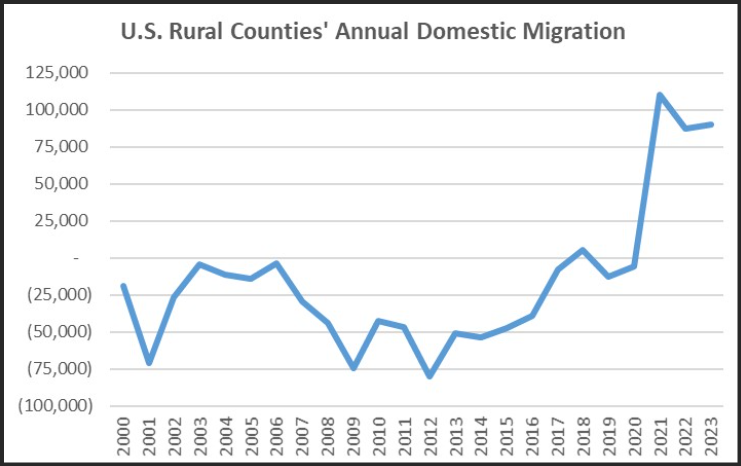
by James A. Bacon
Remote work isn’t the only trend encouraging Americans to relocate from major metropolitan areas to small towns and rural communities, suggests Hamilton Lombard in a new StatChat post. The rise of social media has allowed smaller communities to emulate the entertainment and culinary offerings of big cities, while the rise of Amazon.com puts even remote communities within one-day delivery of the world’s largest marketplace of retail products.
The lower cost of real estate has always favored rural/small town America, but that advantage has been more than offset by the “agglomeration” effects of big metros with larger, deeper labor markets and clusters of industry expertise. New technologies are tilting the balance back toward smaller communities. Even as professionals and free-lancers find it easier to make a living in remote areas and smaller metros, Lombard observes, they enjoy access to a greater range of amenities than ever before.
There’s another factor that Lombard omits, no doubt because of its intrinsically political nature — he is scrupulously apolitical in his analysis — and that is the growing unease at signs of social breakdown. Decriminalization of minor crimes. Disorder in schools. Protests on college campuses. Homelessness and tent cities. A sense that things are spinning out of control and that urban elites are either blind to it or are part of the problem.
Whatever the reasons for the migratory shift, the data leave no room for doubt that it is occurring.
“Perhaps the most remarkable statistic in the 2023 population estimates data is that last year the country’s rural counties and smallest metro areas—those with fewer than 250,000 residents—became the top destination for people moving within the country for the first time in decades,” writes Lombard with the Demographic Research Group at the University of Virginia.
While much of the growth is heading to counties and towns with strong natural amenities — waterfront, mountains and outdoor appeal — even rust-belt towns with hollowed-out economies like Martinsville, Va., are seeing gains.
Writes Lombard:
Many other communities less well known to tourists also have seen a surge in new residents in recent years after years of out migration. Martinsville in southern Virginia is one of them. It was once known as “The Sweatpants Capital of the World” due to its now-closed textile mills, and during the 2010s, Martinsville was part of the poorest state senate district in Virginia. However, in recent years, it has experienced some of the strongest wage growth in Virginia. In 2023, the domestic migration rate into the Martinsville region was the second highest among Virginia’s metropolitan and micropolitan areas.
Martinsville even has a Starbucks now.
 The map at right shows the net domestic migration rate per 1,000 residents. Not all rural counties are seeing population gains. The swath of yellow and orange running from eastern Kentucky through West Virginia, Pennsylvania and New York — essentially central and northern Appalachia — still is draining population. But most of the South Atlantic states and Tennessee are seeing hefty influxes.
The map at right shows the net domestic migration rate per 1,000 residents. Not all rural counties are seeing population gains. The swath of yellow and orange running from eastern Kentucky through West Virginia, Pennsylvania and New York — essentially central and northern Appalachia — still is draining population. But most of the South Atlantic states and Tennessee are seeing hefty influxes.
Lombard suggests that the COVID-19 epidemic likely accelerated changes that were becoming evident in the 2010s and will prove lasting.
It wasn’t long ago that in most of rural Virginia it would have been harder to get a shot of espresso than a shot of Virginia’s homemade spirits. Over the last couple of decades, independent coffee shops have become so commonplace in small towns and rural counties across Virginia and the U.S. that it is taken for granted, as is the delivery of virtually any physical product via e-commerce, any type of streaming entertainment, and a wide array of other services, including telehealth and online education.
Over the last couple of decades, there has been a growing perception that America is becoming geographically and culturally divided, but there has also been a convergence in tastes and increasing access to the same products, media, and services. This convergence helped create the conditions that made millions of Americans more willing, in recent years, to move to small cities, towns, and rural counties across the country. If the adoption of remote work turns out to be as transformative as Alvin Toffler expected, then we are likely only at the beginning of a multi-decade period marked by many substantial societal changes.
Then there’s the political wildcard. Pro-Palestinian protests on college campuses across the country have reinforced the impression that social cohesion is fraying. The country is polarized and evenly divided in its sentiments toward President Joe Biden and former President Donald Trump. Who can doubt that if Biden wins the 2024 election, Trump will cry foul and we’ll see right-wing riots reminiscent of Jan. 6, 2020? And who can doubt that if Trump wins, Democrats will resurrect the “resistance” they launched in 2016, and the country will see a resurgence of George Floyd-style protests?
When urban areas are afflicted by riots and civil disorder, people flee — the farther from the center city the better.

Leave a Reply
You must be logged in to post a comment.